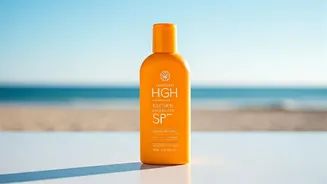The SPF Explained
Sun Protection Factor, or SPF, acts as your skin's shield against the sun's damaging ultraviolet (UV) rays. It measures the amount of time it takes for
your skin to redden when exposed to sunlight compared to not using sunscreen. For instance, SPF 30 means it would take 30 times longer for your skin to burn than without any protection. The protection offered by SPF primarily guards against UVB rays, the primary cause of sunburn. These rays play a critical role in the development of skin cancer and premature skin aging. Applying sunscreen with a suitable SPF significantly minimizes this risk, making SPF an indispensable part of your skincare routine, particularly in a tropical climate like India's, where sun exposure is considerable.
Choosing the Right SPF
Selecting the appropriate SPF level depends on your skin type, the intensity of the sun's rays, and the duration of your sun exposure. Dermatologists typically recommend using a sunscreen with at least SPF 30. This level filters out about 97% of UVB rays. If you have fair skin, are prone to sunburns, or plan to spend a lot of time outdoors, a higher SPF, like 50 or above, may be more suitable. It's essential to consider your daily activities. For example, if you spend most of your day indoors but occasionally step outside, SPF 30 might suffice. However, if you're frequently exposed to the sun, especially during peak hours (10 AM to 4 PM), a higher SPF is advisable. Always read product labels to ensure the sunscreen is broad-spectrum, meaning it protects against both UVA and UVB rays.
Proper Sunscreen Application
Applying sunscreen correctly is just as important as choosing the right SPF. It’s recommended to apply sunscreen generously about 15-30 minutes before sun exposure, allowing it to fully absorb into the skin. Most people do not apply enough sunscreen, which dramatically reduces its effectiveness. Generally, one ounce of sunscreen (a shot glass full) is needed to cover the entire body. The application needs to be even, covering all exposed areas including easily-missed spots like ears, neck, and the tops of feet. Don't forget areas like the lips, where using a lip balm with SPF is crucial. Remember to reapply sunscreen every two hours, or more frequently if swimming, sweating, or toweling off. Consistent and correct application ensures optimal protection.
Beyond Sunscreen: Prevention
While sunscreen is an essential part of sun protection, it's not the only defense. Combining sunscreen with other preventative measures significantly boosts your skin's safety. Seek shade, especially during the sun's peak hours. Wearing protective clothing, like long sleeves, pants, and wide-brimmed hats, provides a physical barrier against UV rays. Sunglasses with UV protection are essential to shield your eyes and the delicate skin around them. Planning outdoor activities for early morning or late afternoon can also reduce your exposure to the strongest sunlight. Consider that surfaces like sand, water, and snow reflect sunlight, intensifying exposure. Being proactive in your sun protection routine creates a comprehensive approach to safeguarding your skin from sun damage.













